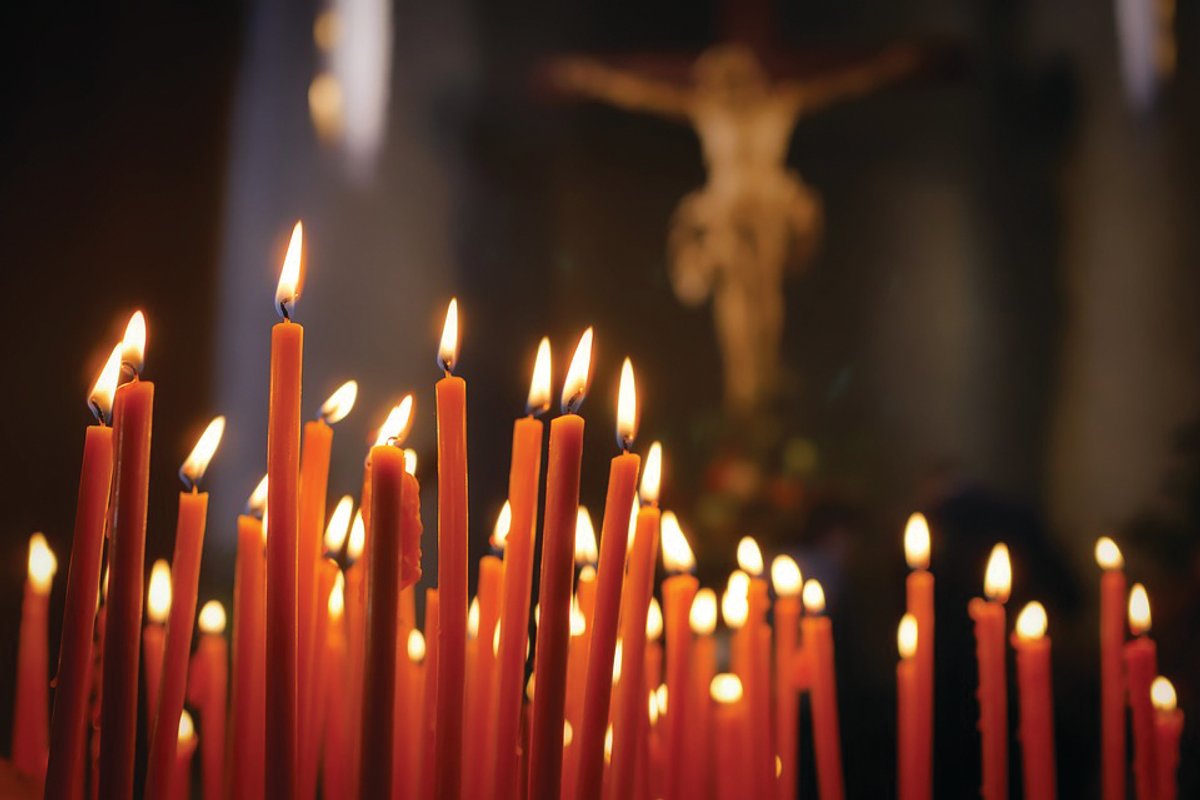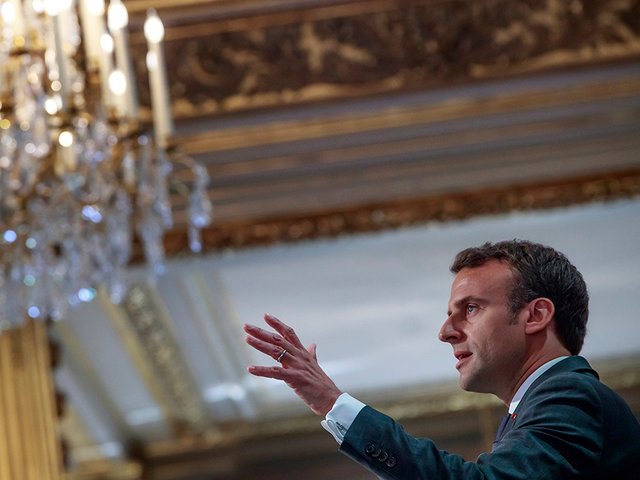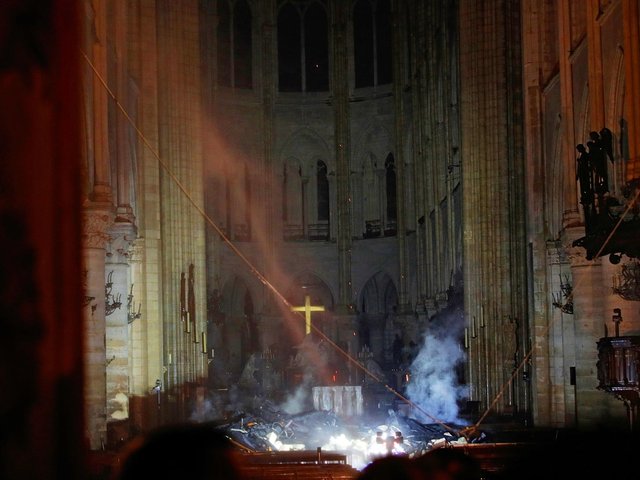France
Michel Aupetit, the Archbishop of Paris: "We feel very deeply that we need not only to rebuild our cathedral but also our Catholic Church, whose face is so wounded. I propose that all people of good-will put a candle in their windows on Easter night just as we will doing in the churches at the beginning of the Easter vigil with the rite of the new fire. Its meaning is that the light illuminates the darkness, that life triumphs finally over death. Dear brothers and sisters, dear friends, may this disaster allow our country to find a happy unity again so that we build together what is inscribed on the façades of our public buildings: fraternity. We believe that it finds its origins in the fatherhood of God, the source of all love." Paris.catholique.fr, 16 April
Isabelle Rey-Lefebvre, a journalist for Le Monde: "'Victor Hugo thanks all the generous donors to the saving of Notre Dame and suggests they do the same for the Misérables’. This tweet by the essayist Ollivier Pourriol, posted Wednesday 17 April and shared 16,000 times, has resonated with charities and those running associations fighting against poverty and insecurity. These words sum up the ambivalent feelings aroused by the flood of money arriving to restore the cathedral… ‘Of course, it is legitimate to be generous towards the rebuilding of Notre Dame, it is a national treasure’, says Florent Gueguen, director of the Féderation des acteurs de la solidarité (FAS), which unites 800 organisations. ‘But one wishes that this enthusiasm was also shown towards the most disadvantaged, towards Solidarity, which is another national treasure’”. Le Monde, 18 April
Audrey Azoulay, the director-general of UNESCO: "Emotionally overwhelmed by the dreadful burning of the cathedral #NotreDamedeParis, a World Heritage Site #Patrimoine mondial since 1991. #UNESCO is following the situation closely and supports France in protecting and restoring this priceless heritage."
Anne Hidalgo, the mayor of Paris: "I’m going to suggest that we organise a big international conference of donors in the next few weeks, which I will host at the Hotel de Ville [town hall], with the benefactors from all over the world, to raise the money needed for the restoration #le79inter #NotreDame"
Jean-Jacques Aillagon, the former minister of culture and the president of the Château of Versailles: "The state should rapidly decree that Notre Dame is 'Trésor national' so that donations for its reconstruction benefit from the 90% tax break provided for in the law relating to benefactions called the Aillagon law. @Elysee @gouvernementFR @MinistereCC"
The Arabic-speaking Middle East
Most prominent religious and political leaders in the Arab world have expressed their solidarity with France, but the fire at Notre Dame has also been seen in the context of the recent and ongoing destruction in the region—the partial demolition of Palmyra by Islamic State in Syria, the bombing by Saudi Arabia and its allies of the Yemeni city of Sanaa, as well as the blowing up of the al-Nuri mosque in Mosul, Iraq, again by Islamic State. There has also been an undercurrent of angry and vindictive comments which state that the French and the West deserved this disaster.
Dr Ahmed al-Tayyib Sheikh, the grand imam of al-Azhar: “I am grieving about the fire at Notre Dame Cathedral in Paris; it is a historical and architectural treasure. Our hearts are with our brothers in France and we offer them every support.” Official Twitter account of al-Azhar, 15 April
BBC Arabic: “The fire at Notre Dame has reminded Arabs on Twitter of the Arabic cultural heritage that the world has lost … Today, people have been sharing pictures of the city [of Palmyra] before and after its destruction, showing the massive historical loss it has suffered, one which they consider as much of a tragedy as the destruction of part of this French cathedral.”
Suhaib Ayoub: “I have been disgusted by some comments, particularly by those who perceived, in the collapse of the tower, some kind of retribution for French colonialism, revenge for its bloody colonial history and for the countries it occupied. I read blood-thirsty comments, filled with hatred. Is it really possible for a reasonable, sensible person to live in our age, to see a historical wonder subjected to insults like this, and not feel pain?” The Lebanese news and comment website, Raseef 22, 16 April
China
The mainstream media carried live reports and articles and the news quickly went to the top of Sina Weibo (China’s version of Twitter). Social media responded vigorously to the news of the fire, with the collapse of the spire and Emmanuel Macron’s speech on the reconstruction of the cathedral being the most widespread images and videos.
There were also nationalistic and critical comments, referring back, for example, to the burning of the Summer Palace in 1860 during the Second Opium War, still a sensitive issue in China today.
The fire at Notre Dame sparked discussion about the protection and restoration of architecture and heritage, especially concerns about the fireproofing of ancient wooden architecture. The bureau of fire suppression and rescue in China's emergency management department posted a video about the fire safety measures in Beijing’s Forbidden City and Palace Museum and photos taken during a conference held at the Palace Museum on fire protection measures have been circulating on social networks.
Ma Yansong, the architect and founder of MAD architects (currently showing at the Centre Pompidou, Paris): “The reconstruction should avoid the use of flammable wood structures. It is recommended to use steel structures and glass roofs for to allow space for sightseeing. Notre Dame has not burnt down; it was only the wooden roof and the 19th-century spire that were ravaged by flames. Any historic building has been through war, fire, lightning, earthquake—disappearance is also part of life. It is unfortunate that the fire happened, but Victor Hugo’s literature will not disappear; beauty, faith and imagination live on”.
Dong Qiang, the head of the French language department at Beijing University: “I believe that Paris has the ability to rebuild Notre Dame…We should not respond to the fire with subconscious feelings of racial antagonism and revenge, nor question the cause of the fire. The essential nature of Notre Dame surpasses history, literature and civilisation."
Italy
Arturo Carlo Quintavalle, a medieval art historian (speaking before it was known how much of the cathedral was saved): “It’s as though the Sistine Chapel were burning; from an historical point of view, it’s the equivalent in damage. Notre Dame is a fundamental monument in the story of Gothic art, the symbol of this key moment, a complex and extraordinary building, full of structural innovations and unique decorative refinements that became the model for other cathedrals." Il Messaggero, 16 April
Vittorio Sgarbi, art historian and TV personality: “We haven’t lost anything. There are no really old works inside it, just the structure and some wall paintings of the second half of the 19th century. It’s not like Italian churches, which are ancient palimpsests. The furnishings are neo-Gothic— stage-design without masterpieces. What have we lost with Notre Dame? Tell me a name, a monument. The Crown of Thorns? A fake. The important part is the two towers, which are intact. Let’s stop wasting words; we need to distinguish between a masterpiece and a picture postcard. Il Messaggero, 16 April
Mariarita Signorini, the president of the heritage lobby group Italia Nostra: “From the tragic experience of the fires that consumed the Fenice Theatre (2001) and the Chapel of the Holy Shroud (1997), we have learnt to follow rigorous safety regulations, one of which is to provide 24-hour warding, never leaving the structure without suitable monitoring. And the more important the site, the more essential it is to train those warders”. Press release, 16 April 2019
Russia

Mikhail Piotrovsky, the director of the State Hermitage Museum and President Vladimir Putin in 2016 Courtesy of The Kremlin
The government, the bishop of Moscow, and many Russian museums all sent messages of condolence. Some museums have posted images of the cathedral from their collections on their social networks. For example, Albert Marquet’s Notre Dame de Paris in Winter of 1908 (1908) in the Pushkin Museum, and Robert Doisneau’s 1969 photo of Notre Dame in the Multimedia Art Museum.
Dmitry Peskov, the spokesman for the Russian president Vladamir Putin: "Russia is ready to help."
Mikhail Piotrovsky, director of the State Hermitage Museum and the president of the Union of Museums of Russia: "On behalf of the Union of Museums of Russia and on my own behalf, I express my condolences to you and the entire French people in connection with the most severe fire in Notre-Dame de Paris. This catastrophe shows once again how fragile our world and its cultural values are, and how difficult it is to protect them from the elements, despite all the technical capabilities of the 21st century. We are grateful to all those who defended the cathedral and its treasures from the fire, and together we will pray for its speedy revival." Statement to the ambassador of France, Sylvie Bermann
Kirill, the bishop of Moscow: "I was deeply saddened by the news of the devastating fire that caused considerable damage to Notre Dame de Paris, the venerated shrine of the Roman Catholic Church in France. I empathise with you, your flock and all those who cherish this masterpiece of Christian temple architecture, which occupies a special place among the world cultural heritage monuments of architecture. I offer prayers to the Lord that He will help overcome the consequences of the fire and soon restore the cathedral to its former glory. I hope that the joint efforts of the Church, the state and all concerned people will be rewarded with success. With Christian love." Statement to Michel Opet, the Archbishop of Paris, 16 April
USA
The reverend James Martin, the author and editor-at-large of America magazine: "Outside of St Peter's basilica in Rome, there is probably no Catholic church as iconic as Notre Dame. It is a place where religion, literature, history, art and poetry come together to form one irreplaceable masterpiece. The ancient structure, lovingly built and even more lovingly prayed in, is certainly one of the most important buildings in Christian history. France is often called 'the eldest daughter of the church,' and Notre Dame is her beating heart. It must be restored." Emailed statement, 15 April
Barbara Drake Boehm, the senior curator at the Met Cloisters: “Notre Dame is the very soul of Paris but also so much more—it is a touchstone for all that is the best about the world, and a monument to the highest aspirations of artistic achievement that transcends religion and time. It has survived so much, from the French Revolution to Nazi occupation; to watch its devastation is excruciating.” Press statement, 15 April
The Metropolitan Museum of Art: “The Met and the collective cultural community are watching in shock and horror at the fire engulfing Notre-Dame Cathedral. We are sending all of our support and strength to the people of Paris—and stand ready to provide any and all resources we can.” Press statement, 15 April
Barack Obama's Twitter [with photo of him with wife and daughters in Notre Dame]: “Notre Dame is one of the world’s great treasures, and we’re thinking of the people of France in your time of grief. It’s in our nature to mourn when we see history lost—but it’s also in our nature to rebuild for tomorrow, as strong as we can.”
The J. Paul Getty Trust : “We are deeply saddened by the tragic fire at Notre-Dame Cathedral in Paris, a treasure of the world's cultural heritage. We extend our sympathies to the people of France and all those who were actively working to preserve its art and architecture.” Press statement, 15 April
Philip Kennicott, the art and architecture critic for The Washington Post: “It will take years to remake the building, and much of what was inside will never be remade. But the great cathedrals of Europe took centuries to build, they have been crumbling for even longer and they will continue to be made and remade. Innumerable lives have been lived out in the shadow of buildings that are half-finished, or missing their towers, or in great disrepair. And now the cycle begins again in Paris, where people will argue over every detail, and fret about who pays for what and whether they should rebuild a Disney fantasy of the past or make it all anew, for a new age. Some daring heretics will even suggest, perhaps, that the building should remain as it is, newly reconfigured for a secular age…” The Washington Post, 16 April
• Compiled by Vittorio Bertello, Raphael Cormack, Milena Orlova, Philippe Regnier, Anna Somers Cocks, Helen Stoilas, Ye Ying




